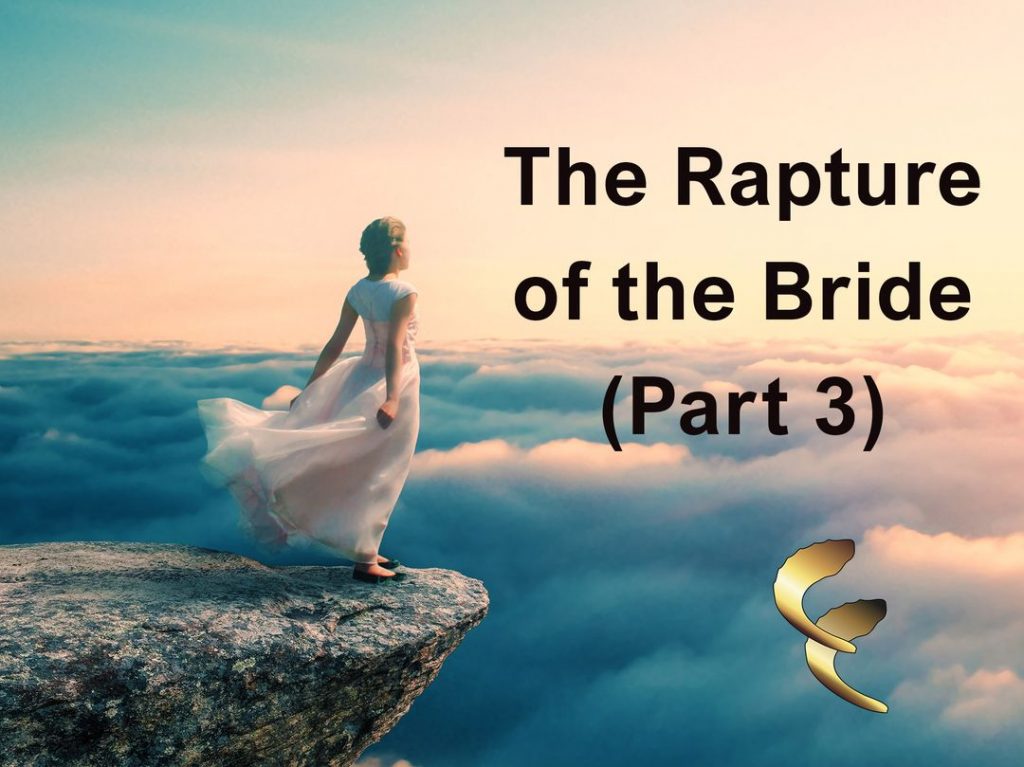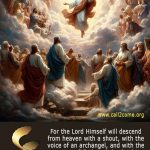
Last time we explored the parable of the Wedding Feast (Matthew 22:1-14) and discovered the Wedding of the Lamb arranged for Israel was not cancelled but extended to include the Gentiles also, and therefore a separate wedding for the church before Israel’s salvation or resurrection of her saints is not Biblically supported. But what’s also very insightful in this parable is that we are given a definition of who the Lord referred to later in Matthew 24 when He spoke of “His Elect”. Now that is extremely useful because identifying “His Elect” should end the rapture debate that has caused so much divide. Here are the key verses again that connect the gathering of the elect with the tribulation.
“(29) “Immediately after the tribulation of those days the sun will be darkened, and the moon will not give its light, and the stars will fall from heaven, and the powers of the heavens will be shaken. (30) Then will appear in heaven the sign of the Son of Man, and then all the tribes of the earth will mourn, and they will see the Son of Man coming on the clouds of heaven with power and great glory. (31) And he will send out his angels with a loud trumpet call, and they will gather his elect from the four winds, from one end of heaven to the other.” – Matthew 24:29-31 ESV
Notice the gathering of “His Elect” will be “after the tribulation of those days”. So the question we are asking is who does Jesus refer to as “His Elect” and that’s where the parable of the Wedding Feast comes to our aid. The word “elect” in the original Greek is “eklektos” (G1588) and it means elect or chosen, it’s the same word used at the end of the parable when Jesus concludes by saying:
“(14) For many are called, but few are chosen [eklektos G1588].” Matthew 22:14 ESV
In this parable, Jesus admonishes the Pharisees and religious leaders for their stubborn refusal to accept Him as their Messiah and confronts their religious pride and misplaced confidence in their natural identity as Israel, Yahweh’s chosen people. This wasn’t the first time their religious pride had been challenged. For example, when the Pharisees came out to meet John the Baptist in the wilderness of Judea he rebuked them saying:
“(9) And do not presume to say to yourselves, ‘We have Abraham as our father,’ for I tell you, God is able from these stones to raise up children for Abraham.” – Matthew 3:9 ESV
Later the Pharisees also encountered Yeshua’s admonition:
“(39) They answered him, “Abraham is our father.” Jesus said to them, “If you were Abraham’s children, you would be doing the works Abraham did,” – John 8:39 ESV
Both John the Baptist and Jesus brought a sword to confront their pride of being Abraham’s children, likewise, this is what we discover in Matthew 22:14; a redefining of who the chosen (eklektos) are. Not by natural birthright of being Jewish, for many had been called (Matthew 22:3) to the wedding, but to be chosen required their acceptance of the wedding invitation and as the parable reveals to wear the right clothes meaning those washed in the blood of the Lamb. Wow, how powerful is that! At this point hopefully, the haze around Israel’s true identity and “His Elect” should be clearing. As Paul writes,
28 For he is not a Jew, which is one outwardly; neither [is that] circumcision, which is outward in the flesh: 29 But he [is] a Jew, which is one inwardly; and circumcision [is that] of the heart, in the spirit, [and] not in the letter; whose praise [is] not of men, but of God. Romans 2:28,29 (NKJV)
Then later, “they are not all Israel who are of Israel, nor are they all children because they are children of Abraham” Romans 9:6,7.
At this stage, I have already laid a number of foundational biblical principles, but before I summarise this short series on the Rapture of the Bride, I’d like us to look at a few resurrection verses. First of all, a selection from the Old Testament.
“(19) Your dead shall live; their bodies shall rise. You who dwell in the dust, awake and sing for joy! For your dew is a dew of light, and the earth will give birth to the dead.” – Isaiah 26:19 ESV
“(15) As for me, I shall behold your face in righteousness; when I awake, I shall be satisfied with your likeness.”– Psalms 17:15 ESV
“(25) For I know that my Redeemer lives, and at the last he will stand upon the earth. (26) And after my skin has been thus destroyed, yet in my flesh I shall see God, (27) whom I shall see for myself, and my eyes shall behold, and not another. My heart faints within me!”– Job 19:25-27 ESV
“(2) And many of those who sleep in the dust of the earth shall awake, some to everlasting life, and some to shame and everlasting contempt.” – Daniel 12:2 ESV
This verse from Daniel is particularly interesting in our study of the rapture of the Bride because it’s part of a much larger vision (see Daniel 12:1-7) that includes “a time of trouble, such as never has been since there was a nation till that time” (v 1), and when asked how long it shall be for the time of trouble and the subsequent resurrection, the answer was “for a time, times, and half a time” which students of Bible prophecy will recognise as three and a half years, the time of the Great Tribulation. The question we are left with then is did that change in any way in the New Testament? Well, let’s take a look at what the apostle Paul affirmed when giving his defence before Felix the governor.
“(14) But this I confess to you, that according to the Way, which they call a sect, I worship the God of our fathers, believing everything laid down by the Law and written in the Prophets, (15) having a hope in God, which these men themselves accept, that there will be a resurrection of both the just and the unjust.” – Acts 24:14-15 ESV
Paul completely upholds the doctrine of the resurrection as it had been revealed through the scriptures, and his conviction finds its way into so much of what he wrote in his letters to the various churches. As when he wrote to the church at Corinth, connecting the resurrection with the last trumpet:
“(52) in a moment, in the twinkling of an eye, at the last trumpet. For the trumpet will sound, and the dead will be raised imperishable, and we shall be changed.” – 1 Corinthians 15:52 ESV
Or when he wrote to the Thessalonians assuring them they hadn’t missed the Lord’s coming or being gathered to Him since that day would be after the rebellion and man of lawlessness revealed:
“(1) Now concerning the coming of our Lord Jesus Christ and our being gathered together to him, we ask you, brothers, (2) not to be quickly shaken in mind or alarmed, either by a spirit or a spoken word, or a letter seeming to be from us, to the effect that the day of the Lord has come. (3) Let no one deceive you in any way. For that day will not come, unless the rebellion comes first, and the man of lawlessness is revealed, the son of destruction,” – 2 Thessalonians 2:1-3 ESV
The apostle Paul knew he could rely upon everything he had come to believe through the Law and the Prophets, even if that meant the cost of his own life. He passionately believed in the One New Man and upholding all the promises made to Israel. His letters do nothing to deviate away from anything written previously in scripture, rather he fervently expounds upon the promises in a way that is entirely inclusive of both Jew and Gentile, not one replacing the other, although he always maintained the centrality of the Jewish legacy. For example,
“(16) For I am not ashamed of the gospel of Christ, for it is the power of God to salvation for everyone who believes, for the Jew first and also for the Greek.” – Romans 1:16 NKJV
Okay, time to wrap this up, and if you’ve reached this far, I really want to thank and honour you for staying with me. It’s not an easy or popular subject to teach, and I’ve found it a challenge not to go down any number of side shoots or “rabbit holes” but try to give a succinct yet honest exegesis on the rapture from a Bridal perspective and let scripture interpret scripture. My intention was not to refute any other view, merely to present as best I could a discourse that interwove scripture in its context and keep both the Bride and Israel in full view.
And so to close here is a summary of the main points presented in sequence that support a rapture after the great tribulation:
There is only one Bride and one Wedding which was originally arranged for Israel. Since the wedding requires a previous resurrection, and the Old Testament saints are not raised until after the great tribulation, it means the one Wedding is also after the great tribulation. The date has not been cancelled, postponed or brought forward, rather the Gentiles have been invited to the Wedding by being “grafted in”, which means adopting the promises and covenants made to Israel. These promises include that of resurrection and therefore rapture as upheld by the apostle Paul. To suggest a pre-tribulation rapture requires a pre-tribulation resurrection, which then requires a different resurrection for Israel as it does for the Gentile church, and if we do that we are creating a separate set of promises and divorcing ourselves from the very one to whom we have been grafted in.






